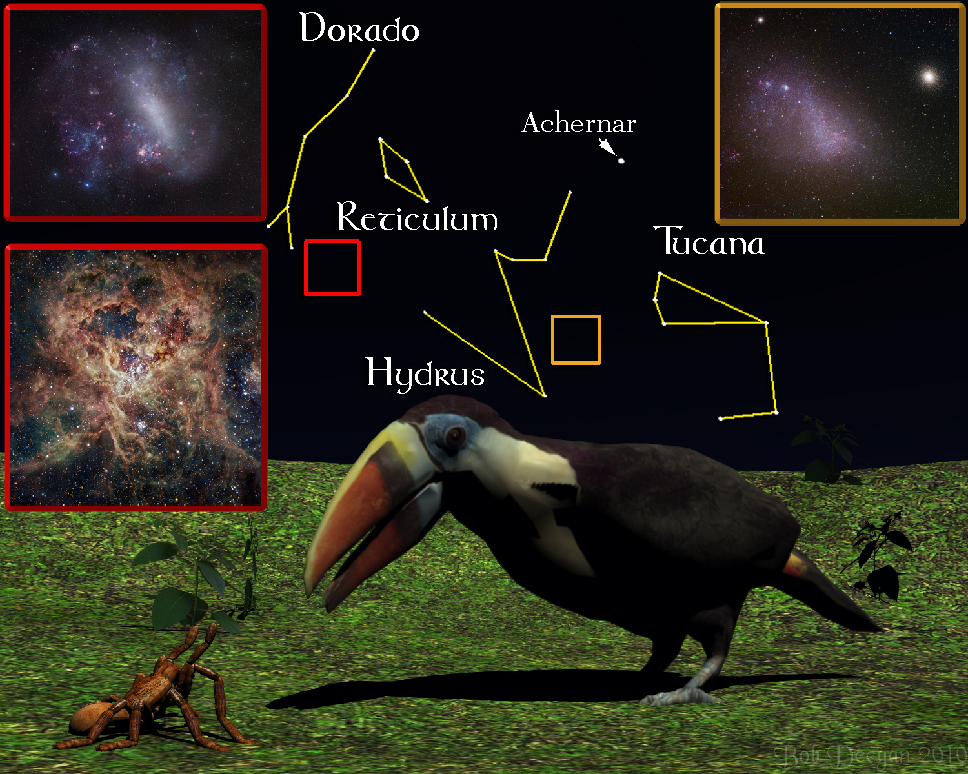
For the week including February 19, 2010

MAGELLAN'S CLOUDS
Travelers to the southern hemisphere have often wondered about two prominent clouds that appear annually and stay in the night sky for some months. They can provide an eerie spectacle for first-time observers as windblown clouds move past them, but they remain still. The logbook made by the Portuguese explorer Ferdinand Magellan in 1521 described them in some detail and they have since become known as the Magellanic Clouds. Because they stand out – even to the unaided eye, the Magellanic Clouds were a puzzle for centuries.
Hundreds of years after Magellan’s voyages, telescopes showed that the Clouds were made of stars, but it wasn’t until the breakthroughs made by Edwin Hubble in the early 1920’s that more of their true nature was learned. The clouds are actually magnificent galaxies that lie less than 180,000 light years from us. This distance is tiny compared to the millions of light years that separate us from our other galactic neighbors. The nearness of these galaxies makes them a perfect subject for study and they have divulged a great deal of information about the evolution of large star-systems.
The upper left photograph in our illustration shows the larger of the clouds, (which astronomers deftly named the Large Magellanic Cloud), in the constellation of Dorado, the Goldfish. This galaxy measures about 50,000 light years across and, if the Large Magellanic Cloud were anywhere else in space, it would resemble a good number of the galaxies we see in telescopes. But its proximity to our giant Milky Way galaxy has caused enormous gravitational disruption in its structure. Instead of finding the patterns of spiral arms that are present in most galaxies, astronomers discovered that the Large Magellanic Cloud has been pulled into an indistinct blur of stars, gases and dust.
If your winter vacationing brings you near the equator, you might consider taking along a pair of binoculars. The Magellanic Clouds are visible below Achernar, one of the brightest stars in the south. With only a little magnification, the Large Magellanic Cloud especially serves up a wealth of breathtaking sights. A close look at the Cloud reveals that the more conspicuous areas of gas and dust are actually stellar nurseries. One of these areas -- evident as a large red patch at the left side of the galaxy -- is the largest yet seen in the universe. Shown in detail at lower left, a vague spider-like shape gave rise to its name, the Tarantula Nebula. Giant hot stars have formed from the gravitational collapse of its gases and their intense ultraviolet radiation makes the remaining gas glow brightly. If this nebula were as near to us as the star-forming sections we see in our galaxy, it would cover almost one third of our night sky and be almost as radiant as the Moon.
The upper right photograph in our illustration shows the smaller of the Clouds, in the constellation of Tucana, the Toucan. Like its bigger sibling, the Small Magellanic Cloud has a gravitationally disrupted structure and luminous star-forming regions. By a chance line-of-sight view, it sits right next to one of the brightest globular clusters in our own galaxy. Visible as a massive ball of stars at the right edge of the photograph, NGC 104 was considered a prime host for planetary systems. In 2000, the Hubble Space Telescope performed a narrow search of 35,000 of its stars and found not a single one.
Photo Credits: Large Magellanic Cloud - Robert Gendler, Small Magellanic Cloud - Robert Gendler & Josch Hambsch, Tarantula Nebula - European Southern Observatory
Unless otherwise indicated, all content of this web site is the copyright of Robert Deegan and all rights are reserved.
For more information, or to comment, please contact: Bob@NightSkies.org